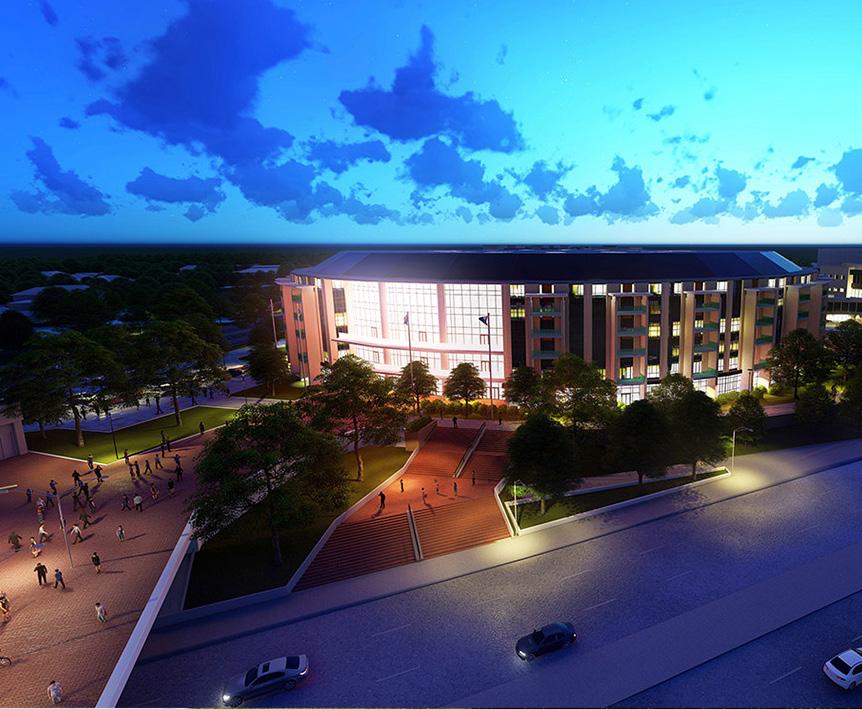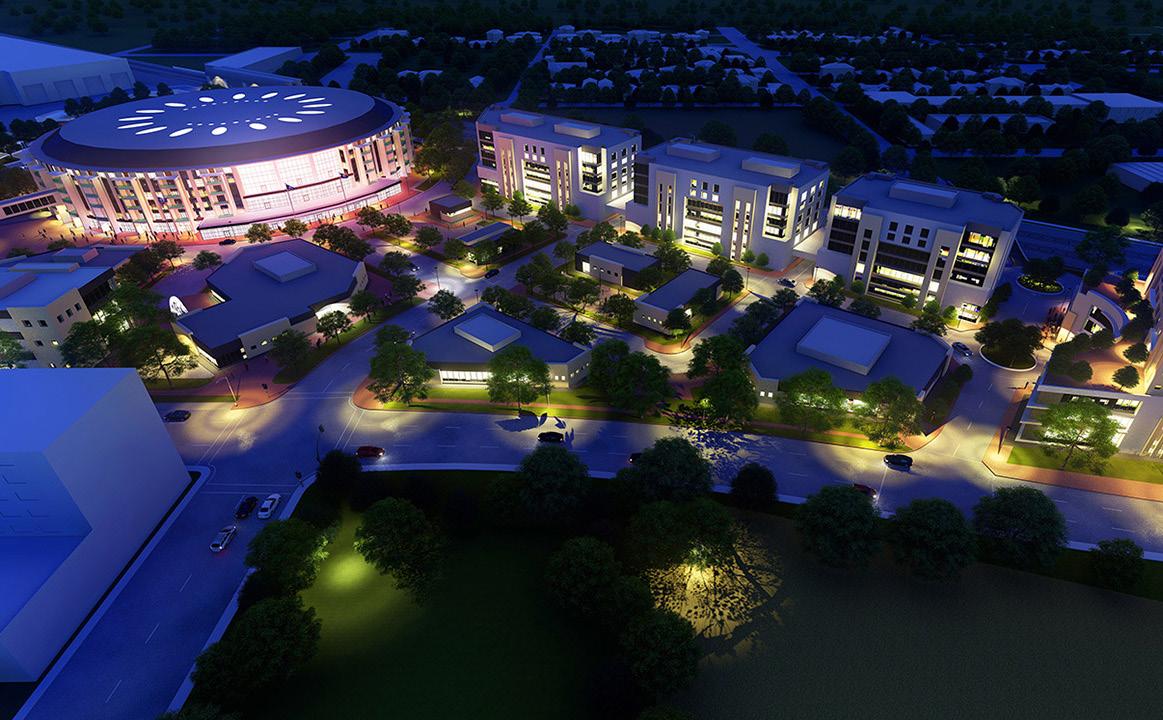
4 minute read
A Whole New Arena
Edmonton’s Northlands resignifies itself as Agora Borealis
By Gloria Alamrew
The question of what to do with the Northlands Coliseum is one that not many people seem too keen to answer. Over the years, it has been called too ugly, too big, too brown, and myriad other indecorous names and, as such, it has largely been forgotten since its closing in 2018. But for one Edmonton architect, Ben Gardner, his morning read of the newspaper in December 2016 sparked an idea that set him and a growing team down a nearly three-year path of (re)imagination: to take the Coliseum’s already impressive size and transform it into something beautiful and still functional for Edmonton’s modern needs.
The Northlands Coliseum was once home to Edmonton’s beloved and much maligned Oilers. Many concerts, shows, and world-class sporting events were held in the cavernous building. Often used as a litmus test for how long you’ve been in Edmonton and whether or not you remember it being called Skyreach Centre, there is no doubt that the Coliseum is an institution of Edmonton architecture and culture. But after it shuttered its doors last year when the new arena in the downtown Ice District was officially opened, it quickly became apparent that the question of what to do with the building and site was still an open question.

The Coliseum closed down in 2018, upon completion of Edmonton’s new Ice District, opening up new opportunities for Northlands’ redevelopment.
DesignWorks
Upon reading that the City was considering demolishing the structure, Gardner did what he knew best: he started drawing. He took the plans of the Coliseum and began drawing over them, searching for a solution hidden in the already existing bones. He quickly realized that the layout easily lent itself to a multi-family residential development. Indeed, converting coliseums into residences was not a new idea. Many similar buildings around the world - most notably the Colosseum in Rome - have been transformed from famed gladiator battlegrounds to comfortable and quiet mixed-use residential developments, complete with green spaces, shops, and community amenities.
Demolishing the Coliseum was surely the easier option, but also wasteful of resources. In the process of developing his idea, Gardner reached out to the team at DesignWorks Engineering, and a few other friends in the design and development industry to put together a team that would develop a cohesive concept for the future of the Coliseum. Haydar Al Dahhan, founder of DesignWorks, led the illustration of the architectural concepts with his team. “We knew that the demolition would cost in the ballpark of 20 to 25 million. So why not take that money and create something amazing? The building’s structure is still in good condition and could easily last another 50-60 years, if not more. The Coliseum in Rome is still standing—why can’t ours?”
When the City decided to issue a Request for Proposal to generate ideas on how to revitalize the building and surrounding site, Gardner’s concept went full steam ahead. A wholly-integrated vision that would offer multiple levels of benefit to not only the surrounding neighbourhoods, but Edmonton in general, was developed and thus, Agora Borealis was born. Its name is a play on the Greek agora meaning “gathering place,” and Borealis, of course, being a nod to our northern location, visà-vis the northern lights natural phenomenon that Edmonton is sometimes lucky enough to witness on a clear night.
Agora Borealis is imagined as a mixed-use facility of the future. The site includes low income housing, a hotel (that would be located in the repurposed Coliseum itself), seniors housing and a community centre. The development would house a total of 700 families and guests and be supported by necessary community infrastructure, such as grocery stores, medical office buildings, shops, and the LRT.
The Coliseum is surrounded by inexpensive, stick-built, 50-year wood frame construction. For an older neighbourhood like this, the chance to reimagine a structure like the Coliseum doesn’t come around often. With vast interior space, it almost begs to be utilized in a way that satisfies a need (more affordable housing), while contributing to a sustainable future — the adage that the greenest building in the world is the one that already exists, rings truer than ever.
At a time where the climate crisis is at the forefront of all policy-making, why shouldn’t it also guide how we reimagine design? With severe wildfires being almost inevitable every summer now, Agora Borealis has more than enough room to safely shelter residents fleeing fire and smoke-filled towns. Disaster relief is something that architects need to think more of in the future, Gardner believes. “The sheer volume of air in [the Coliseum] could sustain people for a long time. Look at Hurricane Katrina, where did everyone go? The arena. A building that can provide disaster relief opportunities is incredibly important. It can literally be a refuge.”
For Gardner, the social capital that Agora Borealis would provide was the clear selling point, and would be well-worth the financial cost. “It’s a world class concept, completely unique to Alberta, Canada and North America. Integrating all types of communities: seniors, neighbourhood residents, and students. If done well, it could even help to put Edmonton on the design map. It’s just so outside anything else that anyone is doing. It is a truly unique—and truly Edmonton idea.”

Agora Borealis offers a fully integrated solution, repurposing the former arena as a mixed-use facility to benefit its community.
DesignWorks
Agora Borealis also boasts a green, integrated design not only for the Coliseum building, but for the site as a whole. On the perimeter edge of the reimagined Coliseum’s roof, there is a band of solar panels that powers all lighting in the main common areas and parking lots, reducing operational costs. Important to a winter city like Edmonton, the site is usable even during the dead of winter. An interior corridor, connecting all areas of the larger site, with plenty of internal green space, is a feature that provides Edmontonians a space with spring and summer environments they could enjoy year-round.
Beyond just satisfying the need for greater urban density and the provision of muchneeded low-income and seniors housing, there is an undeniable sentimental factor behind the motivations to keep the Coliseum alive. In the reimagining of the Coliseum, the storied ice that witnessed four of the Oilers’ five Stanley Cup wins, would remain in miniature, for kids and community members alike to skate on and enjoy for generations to come. Gardner acknowledges that projects like this are ambitious and can seem daunting. “If people were able to reimagine structures like this in the Middle Ages, we can do it again—and we can do it here in Edmonton.”







